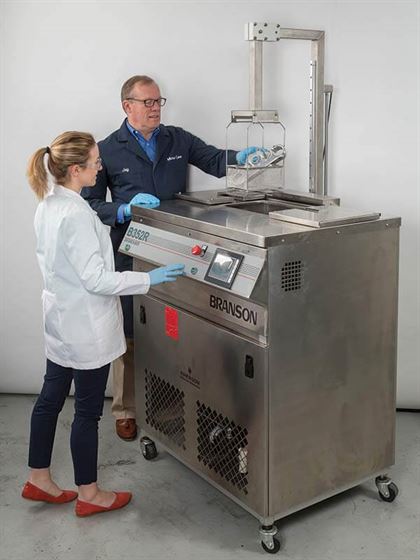Is Personal Protective Equipment Required When Working with Solvents?
Safety first is the prime directive at MicroCare. As such, MicroCare Applications Experts can help you understand how to properly and safely use solvents and cleaning fluids. A MicroCare representative can inspect your facility and your system to ensure that it is working properly; teach your employees about the solvent and present the proper methods for handling and storing the chemicals. So when it comes to safety, MicroCare offers a number of excellent answers. Here are a few general tips for operators:
Skin and Eye Contact:
Eye and skin protection is STRONGLY recommended; see photo.
Common sense strongly recommends that prolonged or repetitive skin contact with any solvent or chemical should be avoided. These solvents remove natural oils from skin, and are particularly adept at dissolving natural oils. This can result in the temporary drying, itching, swelling and roughening of the skin. This temporary irritation of sensitive skin is called temporary local dermatitis. Healing is rapid after the exposure ceases. Impervious gloves and protective clothing really are the best choice if there is any potential for skin contact. Gloves, splash goggles, aprons (when handling open drums), and safety shoes with steel toes are highly recommended.
In terms of gloves, MicroCare recommends gloves made of butyl rubber or other materials to provide optimal protection. In some applications a more durable two-part glove might be necessary. Choose the powderless option if it is important to control nonvolatile residue in your production process. These are widely available from quality distributors everywhere.
Just for the record, we practice what we preach. The staff at MicroCare are expert at moving, blending, handling and storing chemicals. Nonetheless, despite our expertise and familiarity with these chemistries, everybody at MicroCare always wears eye protection and protective clothing in the manufacturing area. If we wear them, your people should wear them, too. It just makes sense.
Inhalation:
Use with adequate ventilation. Avoid product misuse; deliberate inhalation can produce intoxication and be fatal. Vapors are six to eight times heavier than air. Vapors tend to accumulate in low places. Inhalation of concentrated vapors can cause suffocation. Provide forced air ventilation when entering tanks or confined areas. High concentrations of vapors in confined spaces can be fatal due to lack of oxygen. Over-exposures may cause tremors or convulsions. Use exposure monitoring badges to help track and manage worker exposures.
Spill/Leak Management:
In the event of a spill or leak, remove all possible ignition sources and provide ventilation in the event of a spill. Avoid contact with open flames or hot surfaces because the products may produce toxic decomposition products. The smell of the toxic decomposition products serves as a warning agent.

There are a number of accesories which can be added to vapor degreasers to improve cleaning performance and lower costs, including automated hoists (shown here), superheat, and ultrasonics in the rinse tank.
